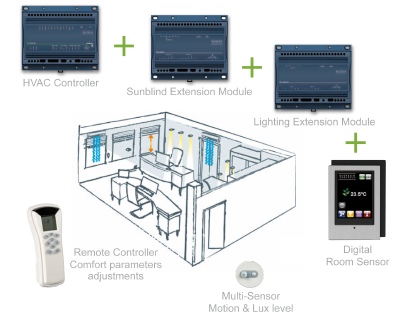Building management needs an holistic approach

Chris Irwin of Distech Controls, discusses the merits of holistic thinking about building management versus the siloed approach commonly adopted today.
An interesting feature of human psychology is that we like to keep things simple — we veer away from complex problems and try to break them down into simpler components. Whilst this approach works well in many instances, it can be very problematic in others. Not every issue can be broken down into simpler parts, and that act of doing so can actually cause a new set of problems.
An example of this is the ‘siloed’ thinking that goes on in relation to the management of buildings. Typically, the requirements of building design are addressed function by function — so lighting, HVAC, metering, security, insulation, facade design etc. tend to be tackled separately by specialists in each area. Problems arise when the solutions that are proposed do not ‘join up’.
A more holistic approach to the design of the controls in a building could produce a much better result, but this requires multi-disciplinary skills to be implemented well. This is a challenge for both services consultants and the various engineering departments in contracting companies to work more collaboratively and ‘join up the dots’ to ensure that overall system cost is minimised and performance maximised.
Too often, the idea of integrating the various sub-systems in a building is ‘bolted on’ to a set of disparate and incompatible systems that have already been selected in isolation. This way of working adds both cost and complexity. Unsurprisingly, such an approach often falls victim to the cost-cutting exercises that occur as the project progresses.
A more holistic approach would be to ensure from the beginning that the system choices being made are compatible by virtue of open communication protocols and the use of a multi-protocol integration platform such as the Niagara Framework. Even better, the electrical and mechanical services teams could co-operate in specifying a multi-functional system that can handle several of the required functions — such as HVAC, lighting and sunblind control. This approach will reduce overall installed cost, as well as lifetime costs, including long-term maintenance overheads.
When looking at existing buildings, we see a similar disconnect between the building controls installed and energy-management solutions. If the existing controls are maintained at all, the maintenance contractors are typically only interested in just keeping the HVAC and other equipment working, with little thought to reducing energy costs, since their remuneration and focus is on maintenance not energy management.
Meanwhile, quite separately, many companies are proposing energy-monitoring solutions and gain a hearing with end users who are anxious to implement such schemes in response to Government exhortations and a growing need to better control rising costs.
The proposed solutions are often quite distinct from the control systems already installed, which offer only monitoring of energy and temperature. A more holistic approach would embrace a solution on site which is capable of both monitoring and control. This approach would eliminate any doubling up on investment caused when the initial monitoring demonstrates the need to implement new control measures.

Pre-occupation with short-term capital costs is often at the expense of longer-term financial considerations. A classic example is the widespread installation of GPRS-equipped electricity meters which can only communicate electricity consumption from one meter back to a central location. Since there is a cost to maintaining GPRS connectivity to the site, a better approach would be to install a GPRS-equipped device on site that is not only capable of reading multiple meters, thereby sharing the GPRS connection cost, but also capable of implementing control measures — since that is the next step after tracking actual energy usage on each site. The initial capital outlay will be higher, but overall the system cost will ultimately be lower.
On one recent project, we worked with an energy-management company which has historically installed data loggers to collect data from clients’ sites and provide energy reports and analysis.
The sites were small, with fewer than 10 monitoring points required per site. The data loggers for this application were about half the cost of a monitoring and control solution but were very limited compared to, for example, a Niagara-based Distech Controls system. However, the data loggers could not implement any control and required a separate communication system. New site hardware would be required to move from monitoring energy use to implementing control logic, enabling a reduction in waste and improvement in the site’s energy performance.
The energy-management company realised that it would, therefore, be far better to propose the more comprehensive Distech Controls solution because it could easily cope with future developments. The client, on this occasion, took the enlightened view that fitting a monitoring-only solution now but then having to install a second box and comms link later was a false economy, so the control-enabled system option was favoured.
The pre-occupation with short-term capital cost to the exclusion of wider life-cycle cost considerations is a recurring theme in the building industry; we naturally want to make the decision simpler. As a result, asking which system is cheaper seems to make the decision easier. Instead, the question, ‘Does this option provide the best long-term performance and efficiency?’ should also be considered. If not, then simply answering the first question risks costing us far, far more in the future.
Chris Irwin is business-development manager for Northern and Eastern Europe with Distech Controls.







